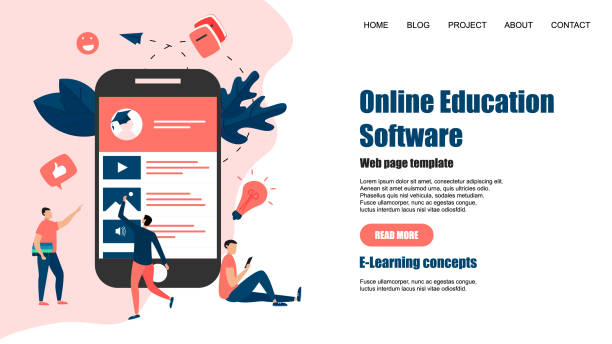Introduction to Responsive Web Design and its Importance in Today’s Era

In today’s fast-paced #web#, where users access the internet through a variety of devices including smartphones, tablets, laptops, and even smart TVs, having a static and unresponsive website can mean losing a huge segment of your audience.
This is where the concept of Responsive Web Design comes into play.
Responsive Web Design refers to a #web_design# approach aimed at creating websites whose layout and content automatically adapt to the screen size and orientation of the user’s device.
This means providing an optimal user experience, regardless of the device used, from the smallest mobile phones to the largest desktop displays.
The importance of this approach has become even more apparent, especially with the significant increase in mobile device usage for internet access.
This is an educational and crucial discussion for any business that wants to succeed in the online space and stay ahead of its competitors.
This approach not only maintains visual appeal but also greatly enhances usability and is recognized as a golden standard in modern web design standards.
Are your online sales not meeting expectations? With Rasaweb, permanently solve low sales and poor user experience!
✅ Increase visitor-to-customer conversion rates
✅ Create an enjoyable user experience and boost customer trust
⚡ Act now for a free consultation!
Why Responsive Design is No Longer an Option, but a Necessity

In today’s digital world, Responsive Web Design can no longer be viewed as a luxury feature; rather, it has become a vital necessity.
One of the main reasons for this is the change in user behavior.
Statistics show that more than half of global web traffic originates from mobile devices.
If your website is not optimized for these users, they will quickly leave your site and move to competitors who offer a better user experience.
This not only leads to a decrease in conversion rates but also negatively impacts your site’s ranking in search engines.
Google and other search engines have explicitly stated that they give better rankings to responsive and mobile-friendly websites (the concept of Mobile-First Indexing).
A properly responsively designed website not only provides a better User Experience (UX) but also offers significant SEO advantages; it is easier to manage and maintain with a single URL and codebase.
This is a deep analytical discussion that demonstrates how neglecting mobile User Experience can harm businesses.
Are you ready to prepare your business for these changes?
Key Principles and Elements in Implementing Responsive Design

Successful implementation of Responsive Web Design is built upon three main pillars: Fluid Grids, Flexible Images, and Media Queries.
Fluid Grids mean that the website layout is defined using percentages instead of fixed pixels.
This allows page elements to dynamically change with varying screen sizes.
For example, if a column has a 50% width, it will always occupy 50% of the available space, regardless of the overall screen size.
Flexible Images ensure that your images and videos do not overflow their containers and scale appropriately with the available space.
This is typically achieved using CSS and setting the max-width: 100%; property for images.
However, perhaps the most important tool is Media Queries.
These CSS3 commands allow you to apply different styles for various screen sizes.
For instance, you can define that on smaller screens, the navigation bar transforms into a hamburger menu or fonts are displayed smaller.
These are technical topics that every web designer must master.
This comprehensive approach ensures a consistent user experience.
Below, the table shows some key comparisons between different web design approaches:
| Feature | Fixed Design | Responsive Design | Adaptive Design |
|---|---|---|---|
| Number of Versions | One version for desktop | One version with dynamic layout | Multiple versions based on breakpoints |
| URL Management | Single URL | Single URL | May have separate URLs (m.site.com) |
| Implementation Complexity | Low | Medium to High | Medium |
| SEO and Ranking | Poor on mobile | Excellent and optimized | Good (if configured correctly) |
Countless Benefits of Responsive Design for Businesses and Users

Responsive Web Design brings significant benefits to both business owners and end-users.
From a business perspective, one of the biggest advantages is increased conversion rates.
When users can easily navigate your site and your content is displayed well on any device, the likelihood of them becoming customers is much higher.
Also, by having only one version of the site for all devices, maintenance and development costs are significantly reduced.
Instead of managing multiple site versions (one for desktop, one for mobile), you only need to update a single codebase.
In terms of SEO, as mentioned earlier, Google gives better rankings to responsive sites, which itself means increased visibility and organic traffic.
For users, the most important benefit is an unparalleled and consistent user experience.
They can easily access the information they need without zooming, horizontal scrolling, or encountering broken elements.
This leads to users spending more time on your site and feeling more satisfied, which results in greater loyalty.
These benefits provide practical guidelines for anyone looking to improve their online presence and demonstrate how closely SEO and Responsive Design are linked.
Tired of losing business opportunities due to a lack of a professional corporate website? Worry no more! With Rasaweb’s corporate website design services:
✅ Your brand’s credibility and professionalism will increase.
✅ You will attract more customers and sales leads.
⚡ Get a free consultation right now to get started!
Challenges and Solutions for Overcoming Them in Responsive Design

Despite all the advantages, implementing Responsive Web Design can also come with challenges.
One such challenge is complexity in CSS and HTML.
To ensure that all elements behave correctly across different screen sizes, you need a precise design and the use of advanced CSS techniques such as Flexbox and Grid Layout.
Another challenge is website performance.
If images are not properly optimized or unnecessary resources are loaded on small devices, site speed will significantly decrease.
This issue is particularly critical for mobile users who may be using slower internet connections.
Solutions include Image Optimization (such as using next-gen formats, Lazy Loading, and SVG), clean and optimized coding for CSS and HTML, and using a CDN for faster content delivery.
Also, thorough testing across different devices and browsers is of paramount importance to ensure a consistent user experience is provided.
This is a challenging question: how to achieve beauty and flexibility without sacrificing performance.
Leading Tools and Frameworks in Responsive Design

To facilitate the Responsive Web Design process, numerous tools and frameworks have been developed that help developers build responsive websites quickly and efficiently.
Bootstrap is undoubtedly one of the most popular front-end frameworks, offering a collection of HTML, CSS, and JavaScript components that are fully responsive.
With its 12-column grid system, this framework enables easy and fast design of responsive layouts.
Foundation is another powerful framework that offers greater flexibility and is suitable for larger projects and more complex customizations.
In addition to frameworks, native CSS features like CSS Flexbox and CSS Grid Layout have revolutionized how web layouts are designed.
Flexbox is ideal for one-dimensional layouts (rows or columns), and Grid is perfect for two-dimensional layouts (rows and columns simultaneously), providing powerful tools for creating complex and responsive layouts without the need for heavy frameworks.
Learning these tools is crucial for anyone looking to master Responsive Web Design and is considered a technical and educational discussion.
The Future of Web Design: The Evolution of Responsive Web Design

The future of Responsive Web Design lies not only in the continued evolution of existing techniques but also in its integration with emerging technologies.
Progressive Web Apps (PWAs) are one of the most important future trends.
PWAs are websites that offer functionality similar to native mobile applications, including the ability to install on the home screen, offline access, and push notifications.
They are naturally responsive and provide a richer user experience.
We are also witnessing advancements in CSS Container Queries, which allow styles to be applied based on the size of the parent container rather than the Viewport (overall screen size).
This feature gives designers more precise control over elements and makes the responsive design process more logical.
The discussion around Artificial Intelligence (AI) in Web Design is also emerging, with tools that can automatically suggest optimal layouts based on user and device data.
This is a news and analytical outlook on the upcoming developments in the field of Responsive Web Design, demonstrating that the boundaries of creativity and technology are expanding.
These advancements bring new challenges and opportunities for developers and businesses.
Below, we have taken a look at milestones and future trends in web design:
| Period | Main Trend | Key Technologies | Distinguishing Feature |
|---|---|---|---|
| Before 2010 | Fixed Design (Desktop-first) | HTML Tables, Simple CSS | Fixed pixels, horizontal scrolling |
| 2010-2015 | Responsive Design | Media Queries, Fluid Grids, Flexible Images | Compatibility with various devices |
| 2015-2020 | Mobile-First, Component-based | Flexbox, CSS Grid, UI Frameworks | Focus on mobile experience |
| 2020 onwards | PWAs, AI in Design, Micro-frontends | Container Queries, Web Components | App-like experience, personalization |
Best Practices for Successful Responsive Design Implementation

To ensure the successful implementation of Responsive Web Design, adherence to several best practices is essential.
The first and most important of these is adopting a “Mobile-First” approach.
This means starting your design for the smallest screens first, and then gradually adding features and complexities for larger devices.
This approach ensures that the most important content and functionalities are available to mobile users first and helps optimize performance.
The second point is optimizing content for different devices.
Sometimes it may be necessary to simplify content or change its prioritization for mobile devices.
Attention to performance should always be a priority.
Optimize images, use a CDN, and minify your code.
Also, do not neglect Accessibility.
Ensure that your site is usable for users with different abilities, including those who use assistive technologies.
Continuous testing on actual devices and simulators is also a crucial step.
These are practical guidelines that will put you on the right path to Responsive Web Design.
Tired of losing business opportunities due to a lack of a professional corporate website? Worry no more! With Rasaweb’s corporate website design services:
✅ Your brand’s credibility and professionalism will increase.
✅ You will attract more customers and sales leads.
⚡ Get a free consultation right now to get started!
Measuring Success and Continuous Improvement in Responsive Design

After implementing Responsive Web Design, the work is not over.
Instead, the important stage of measuring success and continuous improvement begins.
Using Web Analytics tools like Google Analytics is essential for tracking traffic from various devices and user behavior on each.
Pay attention to metrics such as Bounce Rate, time spent on site, and conversion rates across mobile and desktop devices.
If the bounce rate on mobile is high, it indicates a problem with the mobile user experience that needs investigation.
User feedback is also a valuable resource for improvement.
You can use surveys, usability tests, and even listen to social media to understand users’ pain points.
Also, A/B testing to experiment with small changes in design and content can help you find the best performance for each device.
The web world is constantly changing, so continuous updating and optimization of your responsive site is key to maintaining competitiveness and providing the best user experience.
This is an analytical and explanatory process that every business must follow to ensure its success.
The Role of User Experience in Responsive Web Design

User Experience (UX) plays a central role in the success of Responsive Web Design.
A responsive site is only successful when its user experience is seamless and enjoyable across all devices.
This means that navigation should be intuitive and easy, buttons and links should be large enough and clickable (especially for touchscreens), and content should be easily readable, regardless of screen size.
Attention to content prioritization is also highly important.
On smaller screens, there may not be enough space to display all desktop elements.
Therefore, you need to decide which information and functionalities are most vital and should be prioritized.
This may include hiding some elements or changing their arrangement.
The ultimate goal is to reduce friction for the user.
The less a user has to struggle to access information or perform an action, the better their user experience will be.
This aspect of Responsive Web Design is not only an explanatory aspect of design principles but also an engaging topic in terms of problem-solving challenges and UI innovation.
Frequently Asked Questions
| Question | Answer |
|---|---|
| What is Responsive Web Design? | It is an approach in web design that ensures a website is displayed correctly across various screen sizes (e.g., mobile, tablet, desktop) and its layout adapts to the user’s screen size. |
| Why is Responsive Design important? | Given the widespread use of different devices to access the internet, responsive design provides a consistent user experience for all users, reduces the site’s bounce rate, and improves SEO. |
| How is Responsive Design implemented? | This type of design is often implemented using CSS3 Media Queries, Flexible Grids, and Flexible Images. |
| What are the main components of Responsive Design? | These include Media Queries for applying different styles based on device characteristics, using relative units (like percentages and ems) for sizes and layouts, and using flexible images and media whose dimensions change to fit the available space. |
| What are the main benefits of using Responsive Design? | Improved user experience, reduced development and maintenance costs (compared to having separate versions for mobile and desktop), improved search engine ranking (as Google prefers it), and increased site accessibility for all users. |
And other advertising services from Rasaweb Advertising Agency
Smart Direct Marketing: Revolutionize user engagement with SEO-driven content strategy.
Smart Social Media: A creative platform to improve customer acquisition with marketing automation.
Smart Google Ads: A creative platform to improve customer behavior analysis with intelligent data analysis.
Smart Sales Automation: A creative platform to improve customer acquisition with custom programming.
Smart Brand Identity: Designed for businesses seeking to increase website traffic through key page optimization.
And over a hundred other services in the field of internet advertising, advertising consulting, and organizational solutions
Internet Advertising | Advertising Strategy | Advertorials
Resources
Responsive Web Design on TarafdariDigiato’s Guide to Responsive DesignBenefits of Responsive Design from Zoomit’s PerspectiveResponsive Design Tutorial on Iran ICT
? Is your business ready to leap forward in the digital world? Rasaweb Afarin Digital Marketing Agency, with expertise in fast website design, SEO, and comprehensive online marketing strategies, paves the way for your brand’s growth.
For a free consultation and more information about our services that guarantee your online success, contact Rasaweb Afarin’s expert team today.
📍 Tehran, Mirdamad Street, next to Bank Markazi, Southern Kazerun Alley, Ramin Alley, No. 6



